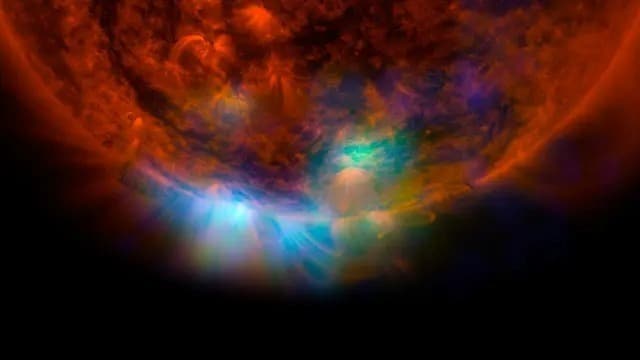Once upon a time, more than 13 billion years ago, shortly after the Big Bang, the universe was a vastly different place. It was a realm devoid of stars, a vast expanse filled with a warm soup of neutral

In today’s universe, stars are born when dense clumps of matter collapse under gravity, triggering the process of nuclear fusion that fuels their existence. However, the early universe faced a significant hurdle—the lack of heavier elements necessary for the rapid release of heat during star formation. Nevertheless, as time flowed like an eternal river, the universe embarked on a journey of transformation.
Deep within the shroud of the cosmic Dark Ages, a team of brilliant astrophysicists sought to unravel the mysteries of the first stars. Armed with sophisticated computer simulations, they delved into the depths of the early universe, where dark matter, neutral gas, and radiation danced an intricate ballet of cosmic evolution. But what set their work apart was the inclusion of an essential element—a phenomenon known as cold fronts.
The team discovered that a grand interplay of interactions unfolded before the birth of the first stars. Neutral gas began to gather and clump together, while the heat released by hydrogen and helium allowed these nascent clumps to gradually attain higher densities. Yet, a challenge emerged—a consequence of the rising density—the clumps grew warmer and emitted radiation that prevented further fragmentation into smaller structures. As a result, the stage was set for the formation of stars unlike any witnessed in the universe’s present era.

These colossal stars, reminiscent of celestial behemoths, emerged from the interplay between radiation and neutral gas. Within the heart of proto-galaxies, they were born, surrounded by rapidly spinning accretion disks, akin to cosmic cradles nurturing their immense mass. Simultaneously, frigid fronts of gas cascaded from the outer reaches of these proto-galaxies, colliding with the accretion disks. The coldest and most massive fronts had a transformative effect, catapulting the mass and density of the disks to a critical threshold, thereby granting life to the first stars.

These stars, unlike any other, were not ordinary fusion factories. Instead, they were colossal clumps of neutral gas that ignited their fusion cores in a magnificent display, skipping the fragmented stages observed in later star formations. As a result, they radiated with an extraordinary brilliance, illuminating the cosmos with their magnificent light. But their existence was fleeting, as their lives spanned less than a million years—a mere blink of an eye compared to the billions of years of their successors in the present-day universe. Their stories came to an end in explosive supernova bursts, where they bid their final farewell.
These cataclysmic explosions disseminated the seeds of future stellar generations. The heavier elements forged within their cores through the magic of nuclear fusion were scattered across the cosmos, sowing the potential for new stars to take shape. Yet, the fate of these colossal stars was sealed in their demise. Subsequent generations of stars became contaminated by these heavier elements, making it impossible for the universe to repeat the formation of such immense celestial bodies. They vanished from the cosmic stage, leaving behind a legacy of wonder and intrigue.
As we gaze into the vast expanse of the night sky, let us remember the giants of the early universe, those colossal stars that burned brightly but fleetingly. Their existence, though transient, provides a glimpse into the exotic nature of the cosmos during its formative years. Through the tireless efforts of astrophysicists and their sophisticated simulations, we continue to unveil the secrets of our cosmic origins and unravel the mysteries of our celestial past.

